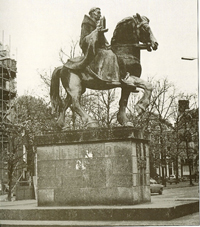|
|
 |
| 
 |
|
The Friesian Horse.
Primitive drawings on the walls of caves in Spain and Southern France and the bones of game found there and elsewhere show that even during the Ice age there were both larger and smaller horses.
Laboushere 1927 found bones of larger and smaller horses in the Friesian mounds.

He lumps the types Equus occidentalis(western horse) and Equus germanicus(German horse) together to the type of Equus robustus (big horse). As for the smaller bones, he supposes that these belong to the Equus Gmelini(tarpan). It is difficult to determine if crosses have been made and if so, to what extent.
The Friesian horse descends from the Equus robustus. During the 16th and17th centuries, but probable also earlier, Arabian blood was introduced, especially through Andalusia horses from Spain. This has given them the high knee action, the small head, and the craning neck. Because of their temperament the Friesian horses are considered warm-blooded. The Friesian horse has been kept free from the influence of the English Thoroughbred. During the last two centuries it has been bred pure. Breeding horses and dealing in them was very important to the Friesians. Also the monks in the many monasteries in Fryslan before the reformation did a lot of horse breeding. Trough the centuries the Friesian Governments have made many regulations in order to safeguard good breeding.
Now the Dutch horse act of 1939 (modified) gives rules for studbook and breeding.
From records of the past we know that the Friesian horse of old was famous. There is information found in books from 1251 till 1811 in which Friesian horses were mentioned and praised.
Export of Friesian horses
According to the Chronicle of Dubravis, the Hungarian king Louis ll used a heavy Friesian stallion when he took field against the Turks on June 15th 1526 a campaign that culminated in the battle of mohacs (august29th 1526).
An etch by Stradanus shows a Friesian stallion, Phryso, from the stables of Don Juan of Austral. Because of their good qualities Friesian stallions were imported, e.g. by the elector George William of Prussia in 1624. Later by the famous Danisch stud at Fredericksburg, by the stud Salzburg, and by the stud Kladrup in 1771 and again in 1974 stallion Romke 1966 FPS 234). Up to the beginnings of this century, Friesian horses were imported for mourning coaches in London.
The well-known English writer on horses, Anthony Dent, and others are of the opinion that the Friesian horse influenced the old English black horse and the Fell pony. Dent proposes that the Norwegian Dole hest (gulkbrandsdat horse), which shows great likeness to the Friesian horse, must have got there from Fryslan either as booty or by regular trade. The Northern Swedish horse was greatly influenced by the Norwegian Dole. Dent also suggests a Norwegian influence on the English Dale Pony. In the Pyrenees in southern France there is a pony áriege called after Merens’ that looks remarkably like a small Friesian horse.
The resemblance of the types mentioned can be traced back in some cases to the influence of Friesian horses/ In other cases the similar way of breeding may have caused the similarity.
As early as 1625 Friesian horses were imported into what later would become the United States of America. The Dutch founded New Amsterdam in the region they discovered in 1609, but in 1664 the English took over the colony and changed its name in New York. Advertisements in the papers offer trotters of Dutch descent. These must have been Friesian horses. The able writer Jeanne Mellin proposes in her books ‘the Morgan horse’1961 and the Morgan horse handboek’1973 the possibility that this well-known American horse is of Friesian descent. The ability to trot fast, the heavy manes, the long rich tail and the fetlocks at the feet of original foregather of this race may be an indication. Again in 1974,1975 and 1977, nine Friesian horses in all were imported into the us, by Thomas Hannon, Friesian farms, Ohio.
With the help of the Friesian studbook Friesian horses have been imported into western Germany by Baron Clemens von Nagel, and into the union of South Africa was meant to improve the type of horse called the Flemish horse. Over there, imported long time ago from Belgium and called after the Flemish part of the country of export. Nowadays this type of horse is not found in Belgium any more, except when imported form Fryslan.
February 1978 Herman Kiestra, who was going to settle near Inverness in Scotland, took with him four Friesian mares and the Friesian stallion Bjinse 1970 FPS 241
 |
|























